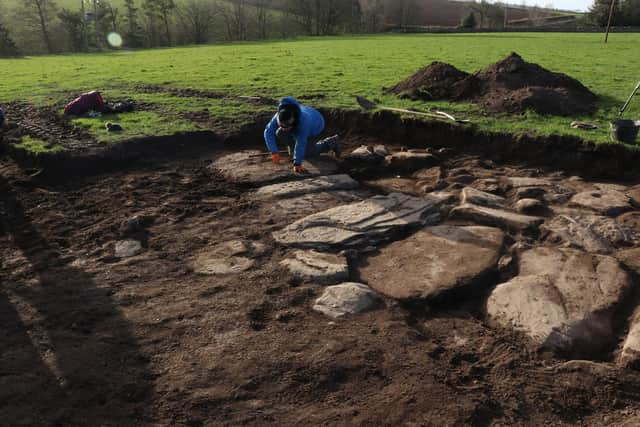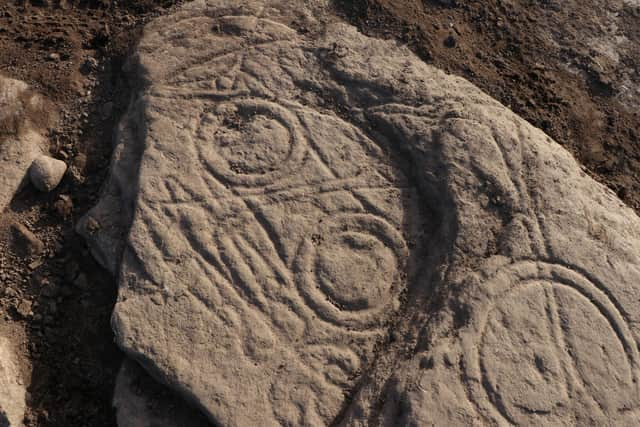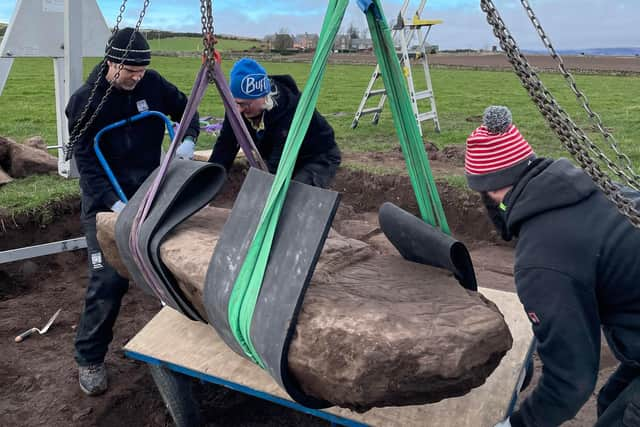Rare Pictish stone found close to 'site of ancient battle' that led to creation of Scotland
The stone was found in a field at Aberlemno near Forfar, an area already well known for its Pictish heritage and a stunning collection of unique standing stones.
The most famous Aberlemno stone is believed to depict scenes from the 7th Century Battle of Nechtansmere, which ended in Pictsh ruler King Bridei Mac Bili defeating Anglo Saxon King Ecgfrith in a victory that halted the expansion of the Anglo-Saxon kingdoms to the north.
Advertisement
Hide AdAdvertisement
Hide AdNow, further evidence of the area’s importance during the Pictish period has been found with the discovery of a symbol stone in a farmer’s field, a few miles away from the likely battle site.


Research fellow Dr James O’Driscoll, of the University of Aberdeen, who initially discovered the stone, said: “We thought we’d just uncover a little bit more before we headed off for the day. We suddenly saw a symbol. There was lots of screaming.
"Then we found more symbols and there was more screaming and a little bit of crying.
“It’s a feeling that I’ll probably never have again on an archaeological site. It’s a find of that scale.”
The stone was discovered as archaeologists examined anomalies in the ground which looked like evidence of a settlement.


The stone, which is thought to date to the 5th or 6th Century and is one of only 200 known, has now been painstakingly excavated with further analysis due.
Professor Gordon Noble, head of archaeology at Aberdeen University, said: “Here at the University of Aberdeen we’ve been leading Pictish research for the last decade but none of us have ever found a symbol stone before.
“There are only around 200 of these monuments known. They are occasionally dug up by farmers ploughing fields or during the course of road building but by the time we get to analyse them, much of what surrounds them has already been disturbed.


Advertisement
Hide AdAdvertisement
Hide Ad“To come across something like this while digging one small test pit is absolutely remarkable and none of us could quite believe our luck.”
The stone appears to be intricately carved with classic abstract Pictish symbols including triple ovals, a comb and mirror, a crescent and V rod and double discs.
It was built into the paving of a “huge” 11th or 12 Century building, where examples of Bronze Age rock art were also found. The building also seems to lie directly on top of another settlement, parts of which are believed to date to the Pictish period.
Prof Noble added: “The discovery of this new Pictish symbol stone and evidence that this site was occupied over such a long period will offer new insights into this significant period in the history of Scotland as well as helping us to better understand how and why this part of Angus became a key Pictish landscape and latterly an integral part of the kingdoms of Alba and Scotland.”
The project has had help from Aberdeenshire Council Archaeology Service and the Pictish Arts Society to get the stone lifted and to the conservation lab, with radiocarbon dating funded by Historic Environment Scotland.
A message from the Editor:Thank you for reading this article. We're more reliant on your support than ever as the shift in consumer habits brought about by Coronavirus impacts our advertisers.
If you haven't already, please consider supporting our trusted, fact-checked journalism by taking out a digital subscription.
Comments
Want to join the conversation? Please or to comment on this article.
